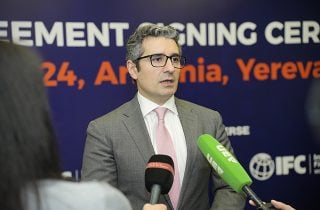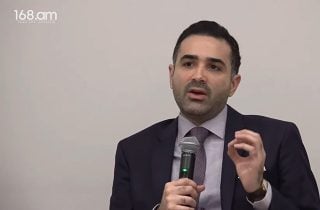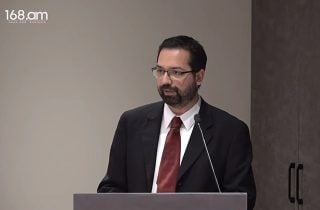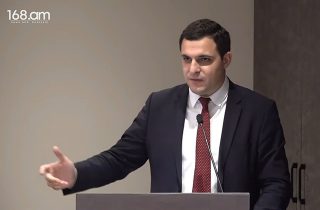
During the first year of accessing the Customs Union we might have a 300 million USD loss

Our guest is the director of the Institute of Economics and Business of the Russian-Armenian (Slavic) University, PhD of Economics Edward Sandoyan.
-Mr. Sandoyan, what is your opinion of the current developments of Armenia?
-Seemingly the path that we have chosen is not the right one. The mechanisms, which were chosen to improve the economy and improve the lifestyle of the society, won’t bring any results. The index of the third trimester of the year – 0,6%, is a very serious indicator, which shows that there are serious issues in our economic system. If we put next to it the inflation of January-February – 9,3%, then we understand that we don’t only have economic stagnation but have a more serious impact on our economy and the solutions should be found in the global grounds of the economy. If we review the developments after 2008 we realize that after the 14,1% slump of 2009 we haven’t recovered yet. According to the WB indexes in 2008 the GDP was 11 billion 662 million USD, in 2010 – 10 billion 138 million and in 2012 – 9 billion 910 million USD.
This means that despite the 7,1% economic growth we still have a bad economy. This has become a subject of debate at the NA but I wouldn’t like to intervene in the statistics. Let’s speak with official numbers. It turns out that we haven’t overcome the index of 2008. Moreover, according to the IMF forecast only in 2017 we will be able to overcome this index. This means a 9-year stagnation. I think our country and our people don’t have that much time to stagnate. We have to grow and develop.
-Another topic of discussion was chosen “Where were we and where are we now?”
-We have used the simplest index in 1991. Of course there is a quantitative growth, especially in the first years of independence but when we are speaking about the indexes of the recent years it seems the economy is plummeting. According to soviet statistics, Armenia’s GDP index per person was higher than of Azerbaijan by 1.21. It meant that Armenians lived 21% better than Azeris. Now it is 0.4. It means we live 2,5 worse. Compared to Georgia this number was 1,27. Now it is 0,84. That means we live 16% worse.
Russia was 0,5. Now it is 0,2. Now we live 5 times worse than Russia. Kazakhstan was 0,85 and now it is 0,25 – 4 times worse. This is our result now but back in 1991 our situation wasn’t good either. We had the earthquake of 1988, Karabakh movement, ecological collapse with Nairit, etc.
If we look at the economic growth in the cumulative aspect in 1991-2012, the economic growth in Armenia amounted to 180%, in Georgia 98%. It means that according to national statistics Georgia still hasn’t reached its 1991 index. . But we exceeded 1.8 times. In that case, what is the matter with our economy? Why are we lagging behind with our GDP? The mildest migration indexes are provided by the World Bank, according to which compared to 1990 we had 27,3% migration or one million people. Unfortunately, we lead all the countries with this index.
We are followed by Georgia but they have their own issues connected with Ossetia, Abkhazia. In 1990 the population was 7,1 million. Now it reached 15 million. I will be silent about the numbers of our population. Foreign direct investments directed reduced in Armenia in the recent years. In 2008, we had 935 million and in 2012 we had 489 million USD. But Georgia has almost twice as much. Azerbaijan has 2 billion USD direct investments. Russia has over 50 billion USD investments. And investments are considered sources of further economic growth. If this process slows down in Armenia we will lag behind from our neighbors several times.
-What will the joining of Armenia to the Customs Union change? And how the distancing from Europe will affect our lives?
-Any integration can indeed bring us benefits or additional risks depending on regimes. If we are integrated with the Customs Union we will have certain facilitation of trade circulation from the members states. Unfortunately I cannot say that we will have positive results with 100% because all the import markets are occupied and monopolized. If there is only one importer the price don’t necessarily have to lower because this single economic subjects gets to decide the prices without relying on supply and demand. So in this case this plus may be neutralized.
We are entering a new regime where there might be contradictions between our current customs fees and the ones imposed by the Union. In this regard we have a lot to do. If the government succeeds in negotiations, which I doubt, we will be able to neutralize the risks. If not then the structure of our economy is very different from the other Customs Union states. Russia and Kazakhstan are exporters of energy resources. We are importers.
If we work in the same field with the same rules we might have serious risks and losses. In non-customs zone this trade will cause essential loss of incomes. Now we are deeply analyzing and calculating the consequences with our Russian and Belarusian counterparts and according to very approximate calculations in the first year we might have 300 million USD loss, which should be refunded at the expense of some other sources. Perhaps it might be the good will of Russia.
The time will show the results of negotiations. On the other hand, the customs integration creates very good conditions for exporters. Goods and services will become more accessible. But in this case, we should take into account the specifics of our economy. Today 23% of trade turnout belongs to Russia, 0,2% to Kazakhstan and 0,7% to Belarus. It means at this stage we don’t have any peculiar markets here. Our natural sources from ore mining mostly go to Europe. The cognac that is shipped to Russia has its niche here and certain price drop will not cause the increase of quantity. It means there won’t be drastic growth but there might be new productions and new investments – auto factories etc.
-But this will require a lot of time.
-Yes, it will require a lot of time. And this integration doesn’t solve our key problem – the absence of railroads and the closing of borders with Turkey and Azerbaijan. This problem won’t be solved whether we go to Customs Union or the EU.
Interviewed by Gayane Khachatryan























